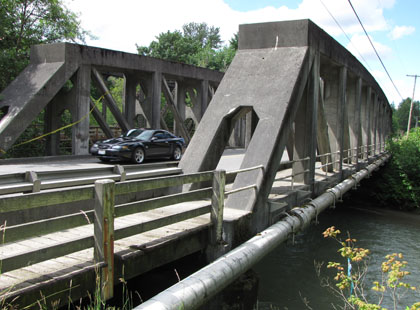Section 106
Overview
As massive government-sponsored construction projects, such as the interstate highway system, and urban renewal in older cities became commonplace after World War II, an estimated 25 percent of the nation's finest historic sites were lost. In response to growing public concern, Congress passed the National Historic Preservation Act (NHPA) in 1966 (16 U.S.C. 470 et seq.). The law established a national policy for the protection of important historic buildings and archeological sites, and outlined responsibilities for federal and state governments to preserve our nation's heritage.
The SHPO is mandated by the NHPA to represent the interests of the state when consulting with federal agencies under Section 106 of the NHPA and to maintain a database of historic properties. The NHPA also created the Advisory Council on Historic Preservation (ACHP), an independent federal agency in the executive branch that oversees the Section 106 review process. In addition to the views of the agency, the SHPO and the ACHP, input from the general public and Native American tribes is also required. The responsibilities of all parties in the Section 106 review process are set forth in federal regulations developed by the ACHP as 36 CFR 800: Protection of Historic Properties.

The NHPA requires any agency issuing a federal permit or license, providing federal funds or otherwise providing assistance or approval to comply with Section 106. A few examples of projects that require compliance with this law include:
- Development activities near or above the water which require a permit from the Corps of Engineers
- The installation of cell towers which require a permit from the Federal Communications Commission
- Construction of municipal wastewater treatment facilities that require permits from the Environmental Protection Agency
- New highway construction projects by the State Department of Transportation that utilizes federal funds
- Local government projects to rehabilitate or demolish housing, using funds from the U.S. Department of Housing and Urban Development
- Cell phone towers and antenna - DAHP uses the FCC E-106 system for all FCC reviews.
Details about Section 106 Regulations (36 CFR Part 800)
- Section 106 Regulations
- A Citizen's Guide to Section 106 Review
- Guía del ciudadano sobre la revisión de proyectos conforme a la Sección 106
- Working with Section 106 - ACHP
- "Reasonable and Good Faith Effort" by Federal Agencies Statement - ACHP
- "Timing and Communication: Section 106 and NEPA" - ACHP
- Relationship of Section 106 to Other Laws
- Nationwide Programmatic Agreements
- Role of the Tribal Historic Preservation Office
- Section 106 and the UN Declaration on the Rights of Indigenous People
- MOA Template
- ACHP memo on Effects - 2019
- ACHP Policy Statement on Burial Sites, Human Remains, and Funeryary Objects - 2023
- DAHP Built Environment Creative Mitigation Summit Recap Powerpoint
General Section 106 Steps
(access the 106 regulations at this link: https://www.achp.gov/sites/default/files/regulations/2017-02/regs-rev04.pdf )
Step One: Consultation Initiation (36 CFR 800.3):
- The lead federal agency will submit a letter addressed to the State Historic Preservation Officer (SHPO) initiating consultation for the project. The consultation initiation letter shall include a brief project summary/overview of the undertaking, the responsible lead agency, and applicable contact information. Other information helpful to add are Tribal participation and identification of other consulting parties. Submit this letter and all subsequent correspondence to 106@dahp.wa.gov. Please note: letters should be addressed to: Dr. Allyson Brooks, Ph.D., State Historic Preservation Officer. Letters uploaded to the 106@dahp.wa.gov intake email address will be retrieved by DAHP project review staff and forwarded to the appropriate DAHP staff members for review and response on behalf of the SHPO.
Step Two: Identification of Historic Properties (36 CFR 800.4):
- The lead federal agency (or lead agency) submits a letter to 106@dahp.wa.gov summarizing the undertaking and accompanied brief verbal description and (using WISAARD’s eAPE tool) include a map illustrating the proposed Area of Potential Effects (APE). The APE should be thought of as the geographic area within which there is any potential for historic properties to be affected by the proposed action (including construction as well as operation).
- Keep in mind, the APE will extend across the land surface but also extends vertically below the surface ground surface to consider archaeology as well as above the surface to consider views. Therefore, this letter must also include a brief, concise justification or explanation for how the APE was defined, specifying all potential effects that were considered. Remember: effects to historic properties can be direct as well as indirect (see ACHP memo on effects). The letter should also ask for DAHP’s concurrence on the submitted APE or comments/recommendations for amending.
- Please note: if appropriate, the lead federal agency may elect to include the consultation initiation letter with the definition of the project APE in the same correspondence.
- It is also important to keep in mind project scopes of work may change over the duration of the design and implementation, especially for large/complex projects. Accordingly, the project APE may also change and change more than once. In the event that the project APE changes, the lead federal agency is responsible for informing the SHPO and affected/interested Tribes and consulting parties of the change and again request comments on the revised APE from all consulting parties.
- Please note: The lead federal will continue consultation with DAHP to determine what, if any, cultural resource investigation will need to occur by providing a proposed survey methodology. Survey efforts must be commensurate with the undertaking.
- The lead federal agency shall utilize their qualified staff and/or employ the services of qualified consultants meeting National Park Service (NPS) Professional Qualifications Standards with expertise commensurate with the property types being evaluated, to inventory all historic and archaeological resources over 50 years in age within the defined APE. All inventory forms shall follow the Washington State Standards for Cultural Resource Reporting (Cultural Resource Reporting Guidelines) and be submitted accordingly through WISAARD. This is done for resources that have not yet been recorded in WISAARD, or have been recorded but has a Determination of Eligibility that is more than 10 years old.
- Based on the inventory of historic and archaeological resources, the lead federal agency will make a determination of eligibility for the identified resources, and forward that determination to the SHPO in a letter with a request for concurrence on the determination(s).
- Once received by the SHPO, DAHP staff project reviewers will review the correspondence, all applicable inventory forms, survey report, and other supporting documentation. Following this review, a DAHP staff reviewer will respond to the agency contact person with a letter of concurrence or non-concurrence on the agency’s determination(s). DAHP has the option of requesting the lead federal agency for additional information about their determination of eligibility and related documentation at any time.
- For further information on how to inventory historic buildings click here.
- For further information on how to inventory archaeological resources click here.
- The inventory must also include previously recorded historic resources. Those already listed on the National Register are automatically considered "historic properties" under Section 106. A resource identified in the APE and determined to be eligible for listing in the National Register is subsequently considered a "historic property" under Section 106 for the remainder of consultation.
- Any resource identified with the project APE and determined to be not eligible for listing in the National Register is not considered a "historic property" under Section 106, and will require no further consideration under Section 106.
Step Three: Assessment of Adverse Effects (36 CFR 800.5):
- 36 CFR 800.5 defines the criteria of adverse effects to be: "when an undertaking may alter, directly or indirectly, any of the characteristics of a historic property that qualify the property for inclusion in the National Register in a manner that would diminish the integrity of the property's location, design, setting, materials, workmanship, feeling, or association." Agencies and project proponents are encouraged to avoid adverse effects. If adverse effects cannot be avoided, they should be minimized to the greatest extent possible. If adverse effects cannot be avoided or adequately minimized, see Step Four, Resolution of Adverse Effects below.
- Based on the inventory of historic and archaeological resources, the lead federal agency will make a determination of the effect(s) that the undertaking will have on historic properties located in the APE. DAHP will provide notice of either concurrence or non-concurrence on these determinations. There are three possible determinations of effects:
- No Historic Properties Affected - No historic properties in the project area because they are less than 50 years old or were determined to be not eligible for listing in the National Register.
- No Adverse Effect - Historic properties were identified within the project APE, but the criteria of adverse effects are not met.
- Adverse Effect - Historic properties were identified within the project APE, and the criteria of adverse effects are met.
- Based on the inventory of historic and archaeological resources, the lead federal agency will make a determination of the effect(s) that the undertaking will have on historic properties located in the APE. DAHP will provide notice of either concurrence or non-concurrence on these determinations. There are three possible determinations of effects:
Step Four: Resolution of Adverse Effects (36 CFR 800.6):
- When there is concurrence that the proposed action will have an Adverse Effect on Historic Properties, DAHP and the project proponent will negotiate and implement a "Memorandum of Agreement" (MOA) to mitigate the adverse effect. In the case of adverse effects to eligible archaeological resources, the proponent must submit a research design to mitigate adverse effects through proper data recovery. Mitigation measures to be incorporated in the MOA are negotiated amongst the lead federal agency, and the SHPO. Interested and affected Tribes may also participate in the negotiations and may request to be a signatory party to the agreement as well as other parties who have a defined role in implementing the mitigation measures (or “stipulations”) in the MOA. Other interested parties may elect to be “concurring” parties to the agreement.
- Note that the federal agency is required to inform the federal Advisory Council on Historic Preservation (ACHP) (https://www.achp.gov) of the adverse effect and invite the agency to participate in the MOA consultation process. The notification must include a description of the project and the alternatives that were considered to mitigate the "adverse effect."
- Once the terms of the MOA are agreed upon by all consulting parties, the final draft is circulated to the signatory parties to sign the document. Evidence of tribal consultation and resolution of any of their concerns must be provided to the SHPO before the SHPO will sign the agreement.
- Once the MOA is signed, the executed document shall be submitted to the SHPO for posting on WISAARD for public viewing and kept on file for future reference.
- Implementation of the stipulations (mitigation measures) is the responsibility of the lead federal agency and/or other consulting parties as defined in the terms of the agreement. Implementation of the mitigation measures must include coordination with the SHPO through DAHP staff including review of draft materials, monitoring, submittal of annual reports, etc. Final products usually are provided to DAHP (and others as appropriate) as a permanent record and evidence that the terms of the agreement have been satisfactorily fulfilled.
Section 106 Training
The Advisory Council on Historic Preservation offers a variety of Section 106 courses which explains the requirements of Section 106 of the National Historic Preservation Act (NHPA), which applies any time a Federal, federally assisted, or federally approved activity might affect a historic property listed in or eligible for listing in the National Register of Historic Places. Additional, DAHP has a variety of short on-line training videos on our YouTube Channel which will help you understand the Section 106 process better.
These course are designed for people who are new to Section 106 review and those who want a refresher on its basic operation. The courses focuses on the steps in the ACHP's regulations implementing Section 106, "Protection of Historic Properties" (36 CFR Part 800), and the roles and responsibilities of the various participants. They also offers practical advice on how to make Section 106 work smarter and more efficiently to resolve conflicts between development plans and historic preservation values.




